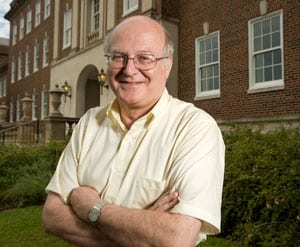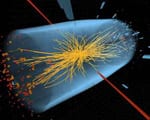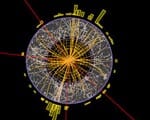The Dallas Morning News interviewed SMU physicist Ryszard Stroynowski about the historic discovery of the new fundamental particle necessary for scientists to explain how matter acquires mass.
The Morning News article, “Dallas-area physicists had a hand in discovery of “God particle,” published July 4.
SMU physicist Stroynowski is a principal investigator in the search for the Higgs boson, and the leader of SMU’s team in the Department of Physics that is working on the experiment.
The experimental physics group at SMU has been involved since 1994 and is a major contributor to the research, the heart of which is the Large Hadron Collider particle accelerator on the border with Switzerland and France.
The discovery results, which are preliminary, were announced July 4 at CERN, the European Organization for Nuclear Research, near Geneva, Switzerland, and at the International Conference of High Energy Physics in Melbourne, Australia. CERN is the headquarters for the LHC lab, which is a collaborative experiment involving thousands of scientists worldwide.
EXCERPT:
By Joe Simnacher
Staff Writer
Three teams of physicists from North Texas were at the heart of the research that discovered the new subatomic particle announced Wednesday.Professors and graduate students from Southern Methodist University, the University of Texas at Dallas and the University of Texas at Arlington were all working in Geneva on Wednesday when the identification of the basic building block of the universe was announced.
“It’s really exciting,” said Dr. Joe Izen, the physics professor leading the UTD team. “I get paid to do this.”
The North Texas teams were part of ATLAS, one of seven larger experiments designed to detect the subatomic particle.
The UTD team created and operated the ATLAS pixel detector, “kind of like an 80 million pixel camera, if you will,” Izen said. It detects the paths of charge tracks so they can be traced to their point of origin.
The SMU team works on the ATLAS liquid argon calorimeter, which measures the energy of photons and electrons.
Dr. Ryszard Stroynowski, physics professor and leader of the SMU team, said he and his colleagues have spent years in Geneva working with equipment they built in Dallas. Stroynowski recently devoted a one-year sabbatical from SMU to the experiment.
“The experiment operates 24 hours a day,” Stroynowski said. “It has to be manned in shifts.”
Follow SMUResearch.com on Twitter, http://twitter.com/smuresearch.
SMU is a nationally ranked private university in Dallas founded 100 years ago. Today, SMU enrolls nearly 11,000 students who benefit from the academic opportunities and international reach of seven degree-granting schools. For more information see www.smuresearch.com.
SMU has an uplink facility located on campus for live TV, radio, or online interviews. To speak with an SMU expert or book an SMU guest in the SMU Broadcast Studio, call SMU News & Communications at 214-768-7650.


 Observed! SMU’s LHC physicists confirm new particle; Higgs ‘God particle’ opens new frontier of exploration
Observed! SMU’s LHC physicists confirm new particle; Higgs ‘God particle’ opens new frontier of exploration Dallas Observer: Has the God Particle Been Found?
Dallas Observer: Has the God Particle Been Found? SMU physicists at CERN find hints of long sought after Higgs boson — dubbed the fundamental “God” particle
SMU physicists at CERN find hints of long sought after Higgs boson — dubbed the fundamental “God” particle DOE Award: advancing SMU’s link to the God particle
DOE Award: advancing SMU’s link to the God particle Dallas Observer: As Physicists Near Discovery of God Particle, A Word With SMU Prof Involved In the Search
Dallas Observer: As Physicists Near Discovery of God Particle, A Word With SMU Prof Involved In the Search WFAA: Super Collider’s legacy lives on in Switzerland
WFAA: Super Collider’s legacy lives on in Switzerland